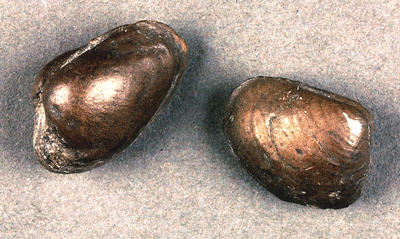
Fossil freshwater mussels (Carbonicola) from Shettleston.
These bivalves (that is, creatures with hinged double shells) are similar in shape to modern freshwater mussels and are often found in the Coal Measures laid down during the Carboniferous Period (360-290 million years ago). At this time Scotland lay close to the equator and was part of a huge low-lying swampy coastal plain which had many rivers and lakes.
The mussels lived in swamps among tropical rainforests. When trees and vegetation died they rotted in the swamps, eventually becoming peat which, through a process of compression, slowly changed into coal. The Coal Measures were created in this way and in central Scotland these include the Ayrshire Coalfield, the Lothians Coalfield and the Central Coalfield.
Reference: 1901.53.ass
Reproduced with the permission of Glasgow City Council, Glasgow Museums
Keywords:
Ayrshire Coalfield, bivalves, Carbonicola, Carboniferous Period, Central Coalfield, Coal Measures, fossils, freshwater mussels, geology, lakes, Lothians Coalfield, rainforests, swamps
You have 47 images in your photo album.